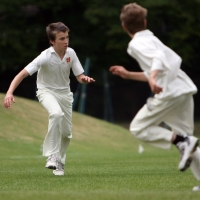Become a Better Fielding Side with Tables
 Here are some things we know for sure:
Here are some things we know for sure:
Catches win matches. 15 runs makes the difference between a tight loss and a comfortable win. Everyone remembers the moment the game turned on a brilliant piece of fielding.
I bet you are thinking of one right now.
These are things we know, things that the coach says again and again (especially after we drop a couple). Yet still there is no accepted measure of fielding skill like batting or bowling average.
No wonder some players - no you, others - don't fancy it.
What's in it for them apart from the wishy-washy talk about "doing it for the team"? They scoff and head back into the nets to put another couple of points on the average.
It's somehow deeply ingrained to find fielding a chore. My club side are a perfect example. During middle practice where I was feeding instead of using bowlers, a 12 year old boy came up to me and asked to bowl. I asked him why; "fielding practice is boring" was his reply.
Depressing? Perhaps.
Revealing? Absolutely.
But the answer might be easier than you think.
Fielding average creates fielding excellence
Think about how much more motivating fielding becomes when you have something you are working towards other than "don't drop that skyer". That's the power of a "fielding average" to go with your batting and bowling numbers.
It's the more advance equivalent of the good old slip catching competition. Remember how motivated everyone was to be the one with the most catches? You can generate the same feeling during games if players know their place in the fielding table is on the line. Cricketers are a competitive lot, even if some are not prepared to admit it!
So, generate a table to go with batting and bowling numbers and keep track of it throughout the season. You'll be surprised how standards raise just by placing it in a prominent place.
How to measure fielding
Of course, this begs the question; what exactly do you measure?
Fielding is only about 3 things: catching, stopping and throwing. So let's put them together.
- Catches are obvious, but they don't tell the story as well as runs or wickets. You may go a handful of games without a chance while the next guy takes 3 and drops 5. Hardly a fair comparison, so take drops into account too.
- Stopping is more complex, but you can use a measure of runs saved minus runs lost. Say you field 2 balls in the game. The first is a brilliant diving stop to save a boundary. the second is a fumble misfield that allows the batsmen to turn for another. 4 saved minus 1 lost is 3.
- Throwing is the hardest to measure, but as a crude indicator you can make sure the scorer registers the thrower for run outs.
As some of these are open to interpretation, the scorer (or coach if she is doing it) is the final arbiter of every one.
The rest is then up to you: I prefer to see a single table that accounts for all of these. For example, you allocate 10 points for a catch or run out, take away 8 points for a dropped catch and then add on the runs saved/lost score to get your fielding number.
You might prefer to keep these all separate, having a different winner in each table.
But the key is to measure and draw up that table.
It's motivating, it's a clear demonstration of the importance of fielding and, most of all, it will make you and your team better in the field: Less frustration, more wins and a great sense of team pride at a job well done.
Give it a try and let me know how it goes!
- Login to post comments

